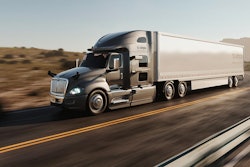 Friction estimates from Goodyear’s SightLine solution were successfully able to detect low grip conditions, such as snowy or icy conditions, and make this information available to Gatik’s autonomous fleet.
Friction estimates from Goodyear’s SightLine solution were successfully able to detect low grip conditions, such as snowy or icy conditions, and make this information available to Gatik’s autonomous fleet.
Autonomous tech developers have taken various approaches to handling a wide range of potential hazards, including using data collected by the tire itself to predict when a problem might arise and making tire problems part of their platform's fail safe protocols.
In partnership with autonomous autonomous middle mile logistics tech company Gatik, Goodyear recently demonstrated in a proof of concept that intelligent tires – in this case using Goodyear SightLine technology – can accurately estimate tire-road friction potential and provide real-time information to Gatik’s automated driving system (ADS). Goodyear SightLine measures tire wear state, load, inflation pressure and temperature and combines that with real-time road/weather data and proprietary rubber friction models to estimate the friction potential, allowing Gatik’s fleet to respond to challenging conditions within its operational design domain (ODD) and adjust route planning and provide recommendations for safe driving speed, vehicle acceleration limits and vehicle following distance.
"The tire is the only part of the vehicle that touches the ground, and this new level of data sophistication can communicate vital information to the vehicle, enhancing safety and performance," said Chris Helsel, Goodyear's senior vice president, Global Operations and Chief Technology Officer. "This is another step to evolve the tire to not only deliver its core, traditional job, but also be a nexus of new data and information."
The two companies recently deployed road-friction detection capabilities in Canada through continuous measurement of tire sensor-derived information, which is paired with other vehicle data and connected to Goodyear's cloud-based proprietary algorithms to optimize vehicle performance. Friction estimates from Goodyear’s SightLine were able to detect low grip conditions, such as snowy or icy conditions, and make this information available to Gatik’s autonomous fleet.
How a truck without a person in the cab might respond in the event of a traction problem has been a focus of autonomous technology developers for some time. Autonomous trucking start up Kodiak Robotics in May became the first company to publicly demonstrate its fallback system, which autonomously pulls a self-driving truck to the side of the road in the event of a truck or system failure.










